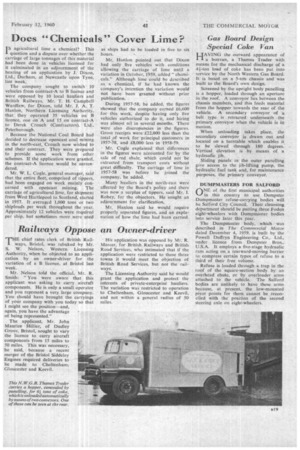Gas Board Design Special Coke Van
Page 53

If you've noticed an error in this article please click here to report it so we can fix it.
HAVING the outward appearance of a box-van, a Thames Trader with means for the mechanical discharge of a 41-ton load of coke has been put. into service by the North Western Gas Board. It is based on a 5-ton chassis and was built to the Board's own design. Screenedby the upright body panelling is a hopper, loaded through an aperture in the roof. A conveyor lies between the chassis members, and this feeds material from the hopper towards the rear of the vehicle. A secondary conveyor of a belt type is retracted underneath the primary conveyor when the vehicle is in motion. When unloading takes place, the secondary conveyor is drawn out and located on a turntable which enables it to be slevved through 180 degrees. Vertical elevation is by means of a hydraulic jib. Sliding panels in the outer panelling give access to the jib-lifting pump, the hydraulic fuel tank and, for maintenance purposes, the primary conveyor.
DUMPMASTERS FOR SALFORD
ONE of the first municipal authorities in this country to use Dempster Dumpmaster refuse-carrying bodies will be Salford City Council. Their cleansing department should be putting three Foden eight-wheelers with Dumpmaster bodies into service later this year. The Dumpmaster body, which was described in The Commercial Motor dated December 4, 1959, is built by the Powell Duffryn Engineering Co., Ltd., under licence from Dempster Bros., U.S.A. It employs a five-stage hydraulic ram acting on a rearward-moving barrier to compress certain types of refuse to a third of their free volume. Refuse is loaded through a trap in the roof of the square-section body by an overhead chute, or by overloader arms attached to the vehicle. The Salford bodies are unlikely to have these arms because, at present, the low-mounted piyot points for them cannot be reconciled with the position of the second steering axle on eight-wheelers.




















































































































